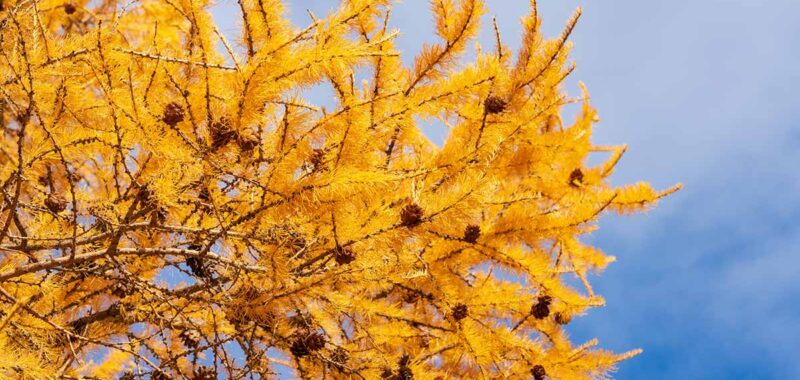7. Swiss
If you’re interested in fast-growing, pretty conifer that tops out at about 100 feet, you’ve found it.
Known as Swiss or Dunkeld larch (L. x marschlinsii), this tree is a hybrid between European and Japanese larch, with blue-green needles that turn electric yellow in the autumn in Zones 3 to 8.


After they drop, pinkish-orange twigs remain. The trunk grows to about eight feet in diameter.
The young cones are green, becoming reddish-purple as they age, and then dark brown when mature.
While the original is a sight to see, there are some notable cultivars. ‘Lilian’ was discovered as a witches’-broom in the Netherlands.
It’s a dwarf plant with a dense, shrubby habit that only grows to about three feet tall and wide.
‘Lulu’ grows as a ground cover or you can train it upright. Either way, the copper colored needles in the fall are a real treat.
8. Tamarack
Also called black, red, or American larch, hackmatack, or tamarack, L. laricina is the predominant native species in eastern North America and one of the most popular options for growing in the home landscape.


This tree can be found in the wild in eastern Canada and the US, from eastern Yukon to the Atlantic and down through West Virginia to the Arctic tree line.
These trees are extremely cold tolerant and can survive down to -80°F, so they’re best grown in Zones 2 to 6.
While they can grow up to 80 feet tall and about half as wide with a pyramidal shape, they usually stay much smaller in the garden and in regions with intense cold.
They can grow in dry soils or rich, peaty, boggy locations, though a nice, moist area is best.
The deciduous blue-green needles turn golden yellow in the fall and then drop to the ground. The tiny half-inch maroon cones persist on the tree indefinitely.


Tamarack Larch Tree
If you’d like to give this classic beauty a spot in your yard, you can find plants available at Nature Hills Nursery.
Or look for cultivars like ‘Fuzzy,’ which was found as a witches’- broom on a tamarack in the upper midwest.
It has fuzzy little needles that remain on the tree throughout the winter before being replaced by fresh foliage in the spring. It’s a shrubby dwarf that only grows a few feet tall.
‘Michigan Tower’ has a narrow growth habit, reaching about eight feet tall but not quite three feet wide.
9. Western
Western larch (L. occidentalis) is a magnificent species. It grows up to 200 feet tall with a trunk that can be nearly five feet in diameter.
The light green needles are soft, growing up to two inches long in dense clusters, on branches that are upswept near the top of the tree and arching near the base.


After the needles turn yellow in the fall, they drop from the tree, leaving behind orange shoots.
The cones are green when young, becoming reddish-purple and then brown when they mature. They turn gray after they die, but they persist on the tree.
This species can only be found in the Pacific Northwest, at high elevations and in cold regions of the Cascade Range and east to western Montana and the Idaho panhandle.
It grows in similar climates but at higher elevations than Alpine larch.

